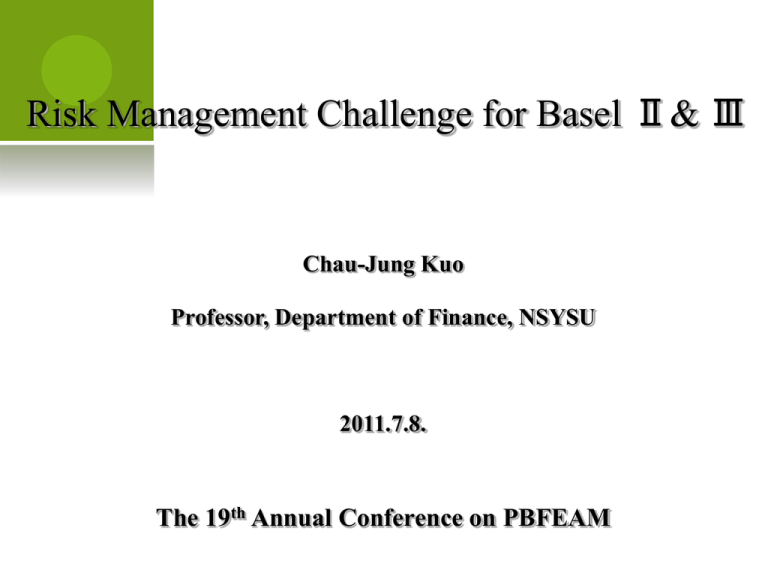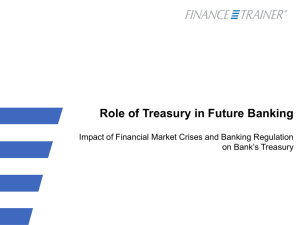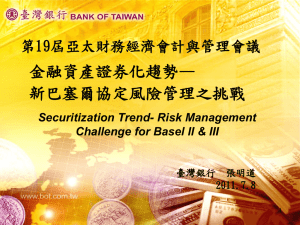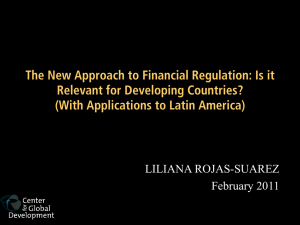2. Chau-Jung Kuo, Professor, Department of Finance, National Sun Yet-sen University , Taiwan ( )
advertisement

Risk Management Challenge for Basel Ⅱ& Ⅲ Chau-Jung Kuo Professor, Department of Finance, NSYSU 2011.7.8. The 19th Annual Conference on PBFEAM The Significant Differences Between Basel Ⅲ and Basel Ⅱ Basel Ⅲ proposes many new capital, leverage and liquidity standards to strengthen the regulation, supervision and risk management of the banking sector. The capital standards and new capital buffers will require banks to hold more capital and higher quality of capital than under current Basel Ⅱ rules. The new leverage and liquidity ratios introduce a non-risk based measure to supplement the risk-based minimum capital requirements and measures to ensure that adequate funding is maintained in case of crisis. 1 Basel Ⅱ Basel Ⅲ Pillar I Pillar Ⅱ Pillar Ⅲ Minimum Capital Requirements Enhanced Minimum Capital, Leverage and Liquidity Requirement Supervisory Review Process Enhanced Supervisory Review Process for Firmwide Risk Management and Capital Planning Disclosure & Market Discipline Enhanced Risk Disclosure & Market Discipline 2 Some Key Elements for The New Regulations Regulatory Element Proposed Requirement 1. Higher Minimum Tier I Capital Requirement Tier I Capital Ratio: increases from 4% to 6%. (The ratio will be set at 4.5% from 1. Jan. 2013, 5.5% from 1. Jan. 2014 and 6% from 1. Jan 2015.) Predominance of common equity will be reached 82.35% of Tier I capital inclusive of capital conservation buffer. 2. New Capital Conservation Buffer Banks will be required to hold a capital conservation buffer of 2.5% to withstand future periods of stress bringing the total common equity requirement to 7%. (4.5% common equity requirement and the 2.5% capital conservation buffer) Banks that do not maintain the capital conservation buffer will face restrictions on payouts of dividends, share buybacks and bonuses. 3. Countercyclical Capital Buffer A countercyclical buffer within a range of 0% ~ 2.5% of common equity or other fully loss absorbing capital will be implemented according to national circumstances. When in affect, this is an extension to the conservation buffer. Source: Bank for International Settlements, Basel Committee on Banking Supervision. 3 Some Key Elements for The New Regulations (Cont’) Regulatory Element Proposed Requirement 4. Higher Minimum Tier I Common Equity Requirement Tier I Common Equity Requirement increase from 2% to 4.5% (The Ratio will be set at 3.5% from 1. Jan. 2013, 4% from 1. Jan. 2014 and 4.5% from 1. Jan. 2015.) 5. Liquidity Standard Liquidity Coverage Ratio: to ensure that sufficient high quality liquid resources are available for one month survival in case of a stress scenario introduced 1. Jan. 2015. Net Stable Funding Ratio: to promote resiliency over longerterm time horizons by creating additional incentives for banks to fund their activities with more stable sources of funding on an ongoing structural basis. Additional liquidity monitoring metrics focused on maturity mismatch concentration of funding and available unencumbered assets. Source: Bank for International Settlements, Basel Committee on Banking Supervision. 4 Some Key Elements for The New Regulations (Cont’) Regulatory Element Proposed Requirement 6. Leverage Ratio A supplemental 3% non-risk based leverage ratio which serves as a backstop to the measures outlined above. (Parallel run between 2013 ~ 2017; migration to Pillar I from 1. Jan. 2018.) 7. Minimum Total Capital Ratio Remains at 8%. The additional of the capital conservation buffer increases the total amount of capital a bank must hold to 10.5% of risk-weighted assets, of which 8.5% must be Tier I capital. Tier Ⅱ capital instruments will be harmonized, Tier Ⅲ capital will be phased out. Source: Bank for International Settlements, Basel Committee on Banking Supervision. 5 Capital Impact of New Definition of Capital Change in Change in CET 1 Tier 1 Group 1 Group 2 -41.3% -24.7% -30.2% -14.1% Change in Total Capital -26.8% -16.6% Change in RWA +7.3% +3.2% Average Capital Ratios Impact from the New Regulations CET 1 Tier 1 Total Gross Net Current New Current New Group 1 11.1% 5.7% 10.5% 6.3% 14.0% 8.4% Group 2 10.7% 7.8% 9.8% 8.1% 12.8% 10.3% * “Gross CET 1” is the ratio of gross CET 1 (without deductions) relative to current risk-weighted assets. “Net” columns show net CET 1 (with deductions) relative to new risk-weighted assets. Source: BIS, “Results of the Comprehensive Quantitative Impact Study”, 6 Basel Committee on Banking Supervision, Dec. 2010.






